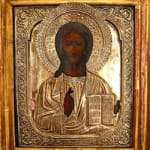Christ Pantocrator, 19th Century CE
Oklad/Oil on Wood
PF.5799
Further images
Russians inherited the tradition of icon painting from Byzantium, where it began as an offshoot of the mosaic and fresco tradition. During the 8th and 9th centuries, the iconoclastic controversy...
Russians inherited the tradition of icon painting from Byzantium, where it began as an offshoot of the mosaic and fresco tradition. During the 8th and 9th centuries, the iconoclastic controversy in the Orthodox Church called into question whether religious images were a legitimate practice or sacrilegious idolatry. Although the use of images was in the end permitted, a thorough distinction between profane art intended to depict reality and sacred art designed for spiritual contemplation was established. That difference is one of the reasons that the artistic style of icons can seem so invariant. Certain kinds of balance and harmony became established as reflections of divinity, and as such they invited careful reproduction and subtle refinement rather than striking novelty. Although this philosophy resulted in a comparatively slow evolution of style, icon painting evolved considerably over the centuries. Unlike the pictorial traditions of the west that aspire towards increased realism and naturalism, the essence of Russian icon painting is not about the representation of physical space or appearance. Icons are images intended to aid in contemplative prayer, and in that sense, are more concerned with conveying meditative harmony than with laying out a realistic scene. They were not painted to please the eye or the mind, but to inspire reflection and self-examination.
A silver-washed oklad covers the majority of this composition. Often, oklads were reserved for only the most sacred images that had the ability to heal the sick and wounded. The oklad has been molded in high relief, a technique known as repoussée, to produce the folds of Christ’s drapery and the interlacing floral motif that decorates the border. A separate piece of metal, again decorated in relief, has been added to represent Christ’s halo. This leaves only the painted surfaces of Christ’s face and hands visible. This effect serves to soften the painted flesh and to give it increased warmth. Jesus is represented here as Christ Pantocrator, the awesome, all-knowing ruler of the universe. He blesses us, forming a sign of benediction with his right hand while holding an open Bible with his left. His face is sympathetic and concerned. His large round eyes draw us towards him. This icon simultaneously depicts Christ as the divine ruler of the world and as a passionate human. We are inspired by his humanity and awed by his divinity. By presenting an approachable image of Jesus, we are brought that much closer to him in our reverence, and therefore, that much closer to God.
A silver-washed oklad covers the majority of this composition. Often, oklads were reserved for only the most sacred images that had the ability to heal the sick and wounded. The oklad has been molded in high relief, a technique known as repoussée, to produce the folds of Christ’s drapery and the interlacing floral motif that decorates the border. A separate piece of metal, again decorated in relief, has been added to represent Christ’s halo. This leaves only the painted surfaces of Christ’s face and hands visible. This effect serves to soften the painted flesh and to give it increased warmth. Jesus is represented here as Christ Pantocrator, the awesome, all-knowing ruler of the universe. He blesses us, forming a sign of benediction with his right hand while holding an open Bible with his left. His face is sympathetic and concerned. His large round eyes draw us towards him. This icon simultaneously depicts Christ as the divine ruler of the world and as a passionate human. We are inspired by his humanity and awed by his divinity. By presenting an approachable image of Jesus, we are brought that much closer to him in our reverence, and therefore, that much closer to God.







